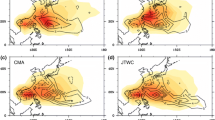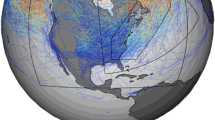Abstract
Simple and easily reproducible techniques have been used to construct two objective cyclone climatologies of the North Atlantic-European sector. The goal of this study is to increase understanding of cyclones with the potential to cause damage, in particular, those reaching Beaufort category 7 and above. The two climatologies constructed here span the period 1979–2000 and have been developed from reanalysis mean sea level pressure data from the ECMWF (European Centre for Medium Range Weather Forecasts) and NCEP (National Centres for Environmental Prediction). The ECMWF reanalysis data are only available for 15 years, and have been extended from 1994 using operational analyses. The major temporal and spatial characteristics of North Atlantic cyclones are examined and a comparison between the climatologies developed from the two data sets is carried out. The well-known cyclogenesis regions along the east coast of the United States and to the southeast of Greenland are replicated by both reanalyses, as is the characteristic southwest/northeast orientation of the dominant cyclone track across the Atlantic basin. However, only weak correlations are found between the time series of cyclone frequency produced from the two reanalyses, and this is particularly true for the lower intensity Beaufort Scale category 0–6 cyclones. This result, together with the large differences in the spatial distribution of cyclones over Greenland for Beaufort Scale 0–6 cyclones, indicates the NCEP reanalyses generates fewer systems than the ECMWF reanalyses. The overall conclusion is that the ECMWF mean sea level pressure data produce a more comprehensive climatology of North Atlantic cyclones at all scales.










Similar content being viewed by others
References
Agee EM (1991) Trends in cyclone and anticyclone frequency and comparison with periods of warming and cooling over the Northern Hemisphere. J Clim 4: 263–267
Alexandersson H, Tuomenvita H, Schmith T, Iden K (2000) Trends of storms in NW Europe derived from an updated pressure data set. Clim Res 14: 71–73
Association of British Insurers (ABI) (1992) Institute of Actuaries ‘Storm Rating in the 90s’ Report. ABI, London, UK, pp 55
Barstow SF, Lygre A (1985) Extreme Atlantic depression during winter 1982–83: effects seen in Norwegian waters. Weather 40: 2–10
Ballenzweig EM (1959) A practical equal-area grid. J Geophys Res 64: 647–651
Blender R, Schubert M (2000) Cyclone tracking in different spatial and temporal resolutions. Mon Weather Rev 128: 377–384
Blender R, Fraedrick K, Lunkeit F (1997) Identification of cyclone track regimes in the North Atlantic. Q J R Meteorol Soc 123: 727–741
Burt SD (1983) New UK twentieth Century low pressure extreme. Weather 38: 209–213
Burt SD, Mansfield DA (1988) The Great Storm of 15–16 October 1987. Weather 43: 90–114
Colucci SJ (1976) Winter cyclone frequencies over the eastern United States and adjacent western Atlantic, 1964–1973. Bull Am Meteorol Soc 57: 548–553
ECMWF (2001) The description of the evolution of the ECMWF forecasting system for the period 1985–2001. www.ecmwf.int/products/data/technical/pdfs/evolution_all.pdf
Gibson JK, Kallberg P, Uppala S, Hernandez A, Nomura A, Serrano E (1999) 1. ERA-15 Description (Version 2 – January 1999), ERA ECMWF Re-Analysis Project Report Series, ECMWF, pp 84
Gulev SK, Zolina O, Grigoriev S (2001) Extratropical cyclone variability in the Northern Hemisphere winter from the NCEP/NCAR reanalysis data. Clim Dyn 17: 795–809
Haak U, Ulbrich U (1996) Verification of an objective cyclone climatology for the North Atlantic. Meteorol Z 5: 24–30
Hayden BP (1981a) Secular variation in Atlantic Coast extratropical cyclones. Mon Weather Rev 109: 159–167
Hayden BP (1981b) Cyclone occurrence mapping: equal area or raw frequencies? Mon Weather Rev 109: 168–172
Hodges KI, Hoskins BJ, Boyle J, Thorncroft C (2003) A comparison of recent reanalysis datasets using objective feature tracking: storm tracks and tropical easterly waves. Mon Weather Rev 131: 2012–2037
Hoskins BJ, Hodges KI (2002) New perspectives on the Northern Hemisphere winter storm tracks. J Atmos Sci 59 (6): 1041–1061
Hosler CL, Gamage LA (1956) Cyclone frequencies in the United States for the period 1905–54. Mon Weather Rev 84: 388–390
Jones PD (1987) The early twentieth century Arctic high – fact or fiction? Clim Dyn 1: 63–75
Jones PD, Goodess CM, Davies TD (2000) ACCORD Report: Atmospheric circulation classification and regional downscaling - Final Report to the European Commission, pp 21–100, http://www.cru.uea.ac.uk/cru/projects/accord/
Kalnay E, Kanamitsu M, Kistler R, Collins W, Deaven D, Gandin L, Iredell M, Saha S, White G, Woollen J, Zhu Y, Chelliah M, Ebisuzaki W, Higgins W, Janowiak J, Mo KC, Ropelewski C, Wang J, Leetmaa A, Reynolds R, Jenne R, Joseph D (1996) The NCEP/NCAR 40-Year Reanalysis Project. Bull Am Meteorol Soc 77: 437–471
McCallum E, Norris WJT (1990) The storms of January and February 1990. Meteorol Mag 119: 201–210
McIlveen R (1995) Fundamentals of weather and climate. Chapman and Hall, London, pp 497
Meteorological Office (1987) The storm of 15/16 October 1987. Meteorological Office, December 1987
Nielsen JW, Dole RM (1992) A survey of extratropical cyclone characteristics during GALE. Mon Weather Rev 120: 1156–1167
Pan H-L, Wu W-S (1994) Implementing a mass-flux convective parametrization package for the NMC Medium Range Forecast Model. Preprints, 10th Conf. on Numerical Weather Prediction, Portland, OR, Am Meteor Soc: 96–98
Schinke H (1993) On the occurrence of deep cyclones over Europe and the North Atlantic for the period 1930–1991. Beitr Phys Atmosph 66: 223–237
Sickmoller M, Blender R, Fraedrich K (2000) Observed winter cyclone tracks in the Northern Hemisphere in re-analysed ECMWF data. Q J R Meteorol Soc 126 (563): 591–620 Part B
Simmonds I, Keay K (2000) Mean Southern Hemisphere extratropical cyclone behaviour in the 40 year NCEP-NCAR Reanalysis. J Clim 13: 873–885
Sinclair MR (1997) Objective identification of cyclones and their circulation, intensity and climatology. Weather Forecasting 12: 595–612
Taylor KE (1986) An Analysis of the biases in traditional cyclone frequency maps. Mon Weather Rev 114: 1481–1490
Tiedtke M (1989) A comprehensive mass flux scheme for cumulus parametrization in large-scale models. Mon Weather Rev 117: 1779–1800
Trigo IF, Davies TD, Bigg GR (1999) Objective climatology of cyclones in the Mediterranean region. J Clim 12: 1685–1696
Trigo IF, Davies TD, Bigg GR (2000) Decline in Mediterranean rainfall caused by weakening of Mediterranean cyclones. Geophys Res Lett 27: 2913–2916
WASA Group (1998) Changing waves and storms in the north-east Atlantic? Bull Am Meteorol Soc 79: 741–760
Woodroffe A (1990) Forecasting the storm of 8 November 1989 – a success for the man-machine mix. Meteorol Mag 119: 129–140
Acknowledgements
The authors would like to thank Isabel Trigo for her valuable assistance. Thanks go to the NOAA-CIRES Climate Diagnostics Center, Boulder, Colorado, USA, for providing the NCEP Reanalysis data via their Web site at http://www.cdc.noaa.gov/ and also the British Atmospheric Data Centre (http://www.badc.rl.ac.uk/) who supplied the ECMWF data. We would also like to thank the Tyndall Centre for Climate Change Research, University of East Anglia, Norwich, UK for providing support throughout the preparation of this work.
Author information
Authors and Affiliations
Corresponding author
Rights and permissions
About this article
Cite this article
Hanson, C.E., Palutikof, J.P. & Davies, T.D. Objective cyclone climatologies of the North Atlantic – a comparison between the ECMWF and NCEP Reanalyses. Climate Dynamics 22, 757–769 (2004). https://doi.org/10.1007/s00382-004-0415-z
Received:
Accepted:
Published:
Issue Date:
DOI: https://doi.org/10.1007/s00382-004-0415-z




